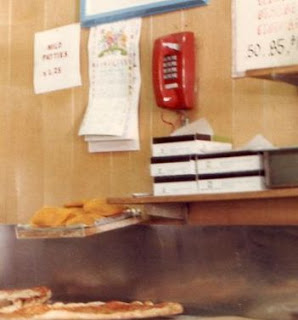As a boy, I was served my mother’s meatloaf too many
times to count. The challenge with that particular fare from yesteryear were
the onions therein. They were not sufficiently sweated, soft, and sweet. My
meatloaf phobia was thus ingrained at a tender age. Things that go crunch in
the night were to be avoided at all costs. I could only abide a smoother than
smooth meatloaf—and the same could be said of meatballs.
My maternal grandmother—an accomplished cook on many fronts—made meatloaf every now and then. While her signature dish—meat pie—was chock full of onions, they were caramelized and succulent. But not so with the meatloaf, which also included crunchy red and green peppers—multiple horrors in one frightful dish. During our summertime visits to Bangor, Pennsylvania, my brothers and I often dined on my grandparents’ back porch. One meatloaf night, my father sensed treachery afoot. His boys would be dining outside downwind of the trash cans on the side of the house. Disposing of the meatloaf without a trace would therefore be a piece of cake. I don’t recall that dinner’s precise denouement, but I suppose we were thwarted and compelled to pick apart the meatloaf, removing the onions and peppers one by one by one. Trust me: That kind of thing gets tiresome real fast, and you go to bed hungry as well.
An aunt of mine also made a meatloaf that was more or less edible. The onions were highly visible but adequately melted. Her secret meatloaf ingredients were oatmeal and a unique spice that I only remember tasting in that meatloaf. The final product, though, had a rather odd consistency. While it was appetizing enough, you could—if so desired—eat the meatloaf with a straw. It would have made a great baby food.
Interestingly, I sampled a fast-food joint’s
meatloaf—Boston Market—not too long ago. It was sufficiently smooth for my
tastes and covered in an appealing barbecue glaze. No crunchies to speak of and
flavorsome, but—in the end—everything from Boston Market leaves my stomach
feeling sour. It comes with age, I guess. All those wonderful take-out
restaurants that I loved so much as a kid just don’t cut the mustard anymore.
One final note on the meatloaf phenomenon. Wherever you encounter it, a surprise awaits. It’s uncharted territory—always: No two meatloafs are the same. This can also be said of chili. My mother and grandmother also made chili with the same gastronomic roadblocks for me: crunchy onions and peppers. Two of my favorite TV detectives were chili aficionados: Lieutenant Columbo and Chief Ironside, with the latter’s unusual kitchen stocked with cans of the stuff. 1960s canned chili…yum. Columbo, meanwhile, repeatedly ordered the stuff in greasy spoons while out and about. I have studiously avoided going down the chili path for the same reason I shouldn’t have ordered the “Meatloaf Special” at the diner. With one notable exception: I have tried Wendy’s chili, which is surprisingly tasty. But, just like the Boston Market meatloaf aftershock, the chili's fast-food finish leaves a lot to be desired. Life lessons learned, forgotten, and learned again.
(Photos from the personal collection of Nicholas
Nigro)



















































